St Mary Abbot's Hospital
Marloes Road, Kensington, W8 5LQ
Medical dates:
Medical character:
1871 - 1992
General, acute. Later, geriatrics, psychiatry.
St Mary Abbot's Hospital had originally been two former workhouses - the Kensington workhouse and infirmary (built in 1847 in the parish of St Mary Abbot's) and the Westminster workhouse with its schoolhouse and separate infirmary (built in 1853 on an adjacent site belonging to the St Margaret and St John parishes).
The main Kensington workhouse was a 3-storey building in the 'Jacobethan style', with a taller central block and projecting wings. It had originally housed 400 inmates, but soon became overcrowded. In 1871 a separate 4-storey infirmary was built in a matching style. It had 375 beds, mainly for the chronically sick. A new dispensary served both in-patients and the poor of Kensington. A 4-storey wing for 300 able-bodied poor was also built; facilities included a laundry and a dining room for the inmates. Over the next two years the workhouse buildings were improved and extended.
In 1875, following the receipt of £2500 from a legacy, a
chapel dedicated to St Elizabeth of Hungary was built, serving both the
workhouse and the infirmary (previously the main dining room behind the
workhouse had been used for services).
In 1878 a mortuary was built at the cost of £182. In the
same year the Westminster workhouse was vacated when the inmates moved
to the new extension to the workhouse in Fulham Road (which later
became St Stephen's Hospital).
Thus, the 3 acre site immediately to the south of the Kensington
workhouse became available and was acquired in 1880 by the Kensington
Board of Guardians.
In 1893 a new administration block was erected in Marloes
Road (in 1890 Wrights Lane had been renamed Marloes Road and, by 1914,
the whole road as far as Cheniston Gardens had been renamed Marloes
Road). Three linked 3-storey ward pavilions for male patients
were built to the south of the administration block, and the 1871
building became an infirmary for female patients. Conditions
continued to improve for staff and inmates. In 1899 new hydraulic
lifts were installed.
In 1908 a Phthisical Committee was formed because of the growing
concern with tuberculosis. It recommended that patients of good
character in the early stages of the disease be sent to sanatoria,
while the chronic and incurable ones remain in the Infirmary in
specially erected verandah accommodation made of iron and glass.
In 1912 the workhouse was renamed the Kensington Institution, while the
hospital facilities became the Kensington Infirmary. Electric
lighting, which had been installed in the chapel and the Guardians'
offices in 1909, was installed in the Infirmary in 1912 and finally in
the Institution in 1923.
In 1923 the Infirmary became known as St Mary Abbot's
Hospital. It had become a general hospital and was used by the
public for the treatment of accidents and for cases of mental illness.
(The Guardians wished to amalgamate the Hospital and Institution,
partly because non-pauper patients resented being transferred to
Institution wards to convalesce.) The postmortem room and
mortuary chapel were improved in 1923, having been rebuilt in 1892
and recognised as inadequate in 1913.
In 1926 the former Westminster workhouse was converted into a Nurses' Home.
The LCC took over administrative control in 1930 and St Mary Abbot's
Hospital became an acute hospital, while the Institution cared for the
chronically ill. The eastern wing of the Hospital - originally
the lying-in wards built in 1886 - was converted into a pathology
laboratory, which also served a local group of hospitals. The
maternity patients moved to the main block. In 1931 the Master of
the Kensington Institution retired and was replaced by a Medical
Superintendent.
In 1933 the Institution became integrated with the Hospital, becoming
St Mary Abbot's Hospital (II), the former infirmary being St Mary
Abbot's Hospital (I). The former Westminster infirmary became a
hospital for young children and infants.
In 1935 the LCC installed two new operating theatres in a new
block which incorporated the western wing of the original lying-in
wards; an anaesthetic room, recovery room and X-ray darkroom were also
added.
During WW2 the Hospital suffered bomb damage in 1940, when four people
were killed and one of the blocks was destroyed. St Mary Abbot's
(II) was forced to close in 1944 when a flying bomb scored a direct
hit. The southern end of the 1847 main block - Stone Hall - and
the 1871 infirmary were destroyed. Five nurses, six children and
seven adult patients died. 33 casualties were transferred to St George's Hospital
and the remainder of the patients evacuated. The Hospital
gradually opened again, still carrying out repairs during its transfer
to the NHS.
In 1948 the Hospital joined the NHS and both parts were united
formally, coming under the administrative care of the Fulham and
Kensington Hospital Management Committee. It became a general
hospital with about 400 beds.
In 1951 the original Guardians' Board Room and offices at 28
Marloes Road were refurbished as a maternity unit and a casualty
department. In 1953 the Metropolitan Ear, Nose and Throat Hospital
moved to the St Mary Abbot's Hospital site, existing as a separate unit
with 27 beds. In 1955 St Mary Abbot's Hospital became an
acute general hospital with 395 beds.
In 1967 a new single-storey building to the west of the original
workhouse block was built to accommodate short-stay psychiatric
patients.
By 1972 the Hospital had begun to specialize in geriatrics and
psychiatry; there were very limited surgical facilities (patients
needing surgery were referred to St Stephen's Hospital).
By this time the Hospital had 268 beds. In 1974 the maternity and
casualty units closed and their premises - the former Board Room and
offices - were demolished to make way for a new 2-storey geriatric Day
Hospital. The chapel, which had been damaged during the war, was also
demolished. It was replaced by a new red brick
inter-denominational chapel, built immediately south of Stone Hall; it
opened in 1977. A further 2-storey building replaced one of the
ward blocks of the former Institution at the northeast corner of the
site.
By 1984 the Hospital had become a long-stay hospital for chronically sick, geriatric or psychiatric patients.
The Hospital closed in 1992, one of the four that closed when the new Chelsea and Westminster Hospital opened on the St Stephen's Hospital site in Fulham Road. The others were the Westminster Hospital, the West London Hospital and St Stephen's Hospital.
|
Present status (February 2008) |
|---|
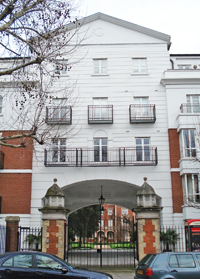
The entrance archway on Marloes Road.
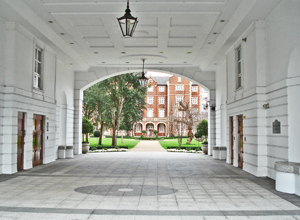
Stone Hall and its courtyard can be seen though the archway.
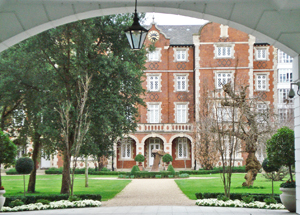
Stone Hall, built in 1847, is the only part of the workhouse that
survives today. Its southern end was destroyed by bombs during
WW2.
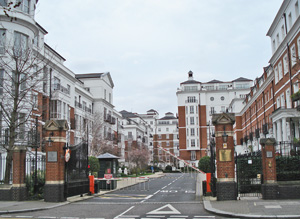
St Mary Close, the guarded entrance to the gated complex. The Hospital's gate posts, railings and gatehouse survive.
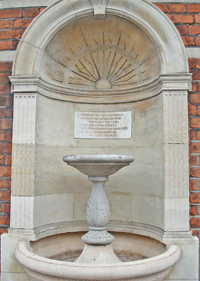
An old fountain set in the Marloes Road wall. The inscription reads "Lord from thy blessed throne * the griefs of earth look upon * God bless the poor! * Teach them true liberty * make them from strong drink free * Let their homes happy be * God bless the poor"
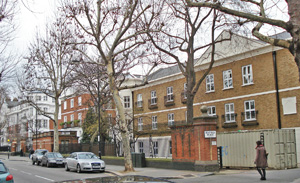
The gated complex from the south.
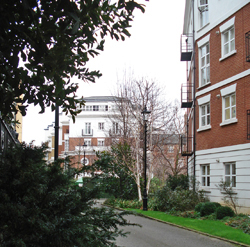
The view of the complex from the north - Stone Hall can just be glimpsed.
In 1970 the 27-year-old rock guitarist Jimi Hendrix was brought here after being found dead of asphyxiation, choking on his own vomit, in an apartment in a private hotel.
References (Accessed 22nd November 2015)
Hughes B 1991 From Workhouse to Hospital. The
Story of St Mary Abbots Hospital, Kensington. London, St Mary
Abbot's Hospital.
www.aim25.ac.uk
www.british-history.ac.uk
www.nationalarchives.gov.uk
www.workhouses.org.uk